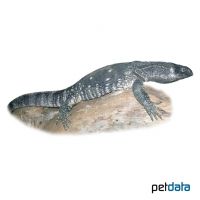White-throated Monitor (Varanus albigularis)
| White-throated Monitor Varanus albigularis | |
|---|---|
| Name | White-throated Monitor |
| Name Lat. | Varanus albigularis |
| Family | Monitor Lizards |
| Family lat. | Varanidae |
| Order | Scaled Reptiles |
| Order lat. | Squamata |
| Origin | Southern Africa |
| Habitat | Steppes, savannas |
| Diet | Insects, rodents |
| Humidity | 50-60 % |
| Behavior | Semi-aggressive |
| Keeping | Individual, pair |
| Care Level | Experts only |
| Reproduction | Oviparous |
| Housing | Semi-humid terrarium |
| Life Span | 12-15 years |
| Protection | CITES Appendix II; EU Annex B |
| Metric Units | |
| Size | 100-150 cm |
| Temperature | 25-30 °C |
| Temperature Local | 40-45 °C |
| Housing Size | 350 x 150 x 150 cm |
| US Units | |
| Size | 40"-59" |
| Temperature | 77-86 °F |
| Temperature Local | 104-113 °F |
| Housing Size | 140" x 60" x 60" |
Distribution and habitat
The diurnal, terrestrial cape monitor lizards are widespread in coastal regions from East Africa (Somalia) to South Africa and West Africa (Angola). They live in the dry savannas and steppes, but avoid deserts.
Maintenance
Recommended minimum dimensions for the terrarium, according to the size and number of animals
| 1-2 animals | 5KRL x 2KRL x 2KRL (L x W x H) |
Head-torso length (KRL) is measured on the largest animal. For each additional animal, increase the footprint by 15%. A terrarium of e.g. 350 x 150 x 150 cm is recommended, which should be placed in a quiet and vibration-free place
They need a spacious terrarium, structured with strong, horizontally mounted climbing branches, tree trunks, cork tubes and rock structures (hiding place and privacy screen), a 15-20 cm deep graveable substrate of sand-clay mixture to be able to build structures as well as a stable drinking vessel. Part of the substrate should always be kept slightly moist, especially the lower sand layers. Once a day, preferably in the evening, the inside of the terrarium should be finely sprayed with water (humidity).
| Temp. day: 25-30 °C | Temp. night: 20-22 °C | Temp. local: up to 45 °C | Humidity: 50-70 |
Thermostatically controlled floor heating is recommended. The lighting duration must be 10-12 hrs. They need high light intensity and daily UV irradiation as well as sunny places with radiant heat.
Diet
The predatory monitors eat everything they can overpower, but also carrion. The food supply consists of insects (crickets, grasshoppers, zophobas, etc.), small rodents, eggs (raw or cooked), etc., as well as meat of beef and game, according to their size. Commercially available ready-made food is also accepted without problems. Wax moths should rarely be fed in very small quantities because of their large fat content. It is important to add minerals and vitamins regularly (e.g. by dusting the feed). Young animals should be offered food daily, adults 3-4 times a week. Drinking water must always be available
A varied diet promotes health and prevents deficiency symptoms.
Reproduction and breeding
The sexes are difficult to distinguish. Reliable sex determination is possible only by radiography or endoscopy. The female lays 9-32 eggs in burrows she has dug herself. The incubation period is 116-177 days at a temperature of 26-32 °C. The young are 20-21 cm in size.
Species protection
The animal population must be reported in writing to the competent authority immediately after the start of keeping. Subsequently, all arrivals and departures must be reported.
Protection of species: WA Annex II; EU Annex B. The proof of purchase is the required proof of origin for the animal. Please keep it safe! Your pet store will be happy to provide you with further information.
Important
They need hiding places and according to their need for warmth sunny places with radiant heat, e.g. stones or branches irradiated with a spot. Males engage in comment fights at the beginning of the mating season. Especially adult animals tend to become obese, therefore a fasting period should be inserted occasionally
A hibernation period of about 2 months at lowered temperature and reduced illumination time is recommended.
The quality of the food animals can be upgraded by giving fruit and honey water.
The terrarium must have good ventilation without drafts and meet the species specific needs. Measuring devices such as thermometers, hygrometers, etc. are necessary. The lighting has to correspond to the species-specific day-night rhythm and has to be placed in such a way that the animals cannot injure themselves. The terrarium should be locked in such a way that neither unauthorized persons can open it nor the animals can escape. Contamination must be removed regularly.
Further literature can be found in your pet store.
References
Text: petdata; Image: petdata
Source: BMELV (1997): Mindestanforderungen an die Haltung von Reptilien; ENGELMANN (2006): Zootierhaltung - Tiere in menschlicher Obhut: Reptilien und Amphibien, Harri Deutsch Verlag
- Gemäß § 21 Abs. 5 Tierschutzgesetz idgF
